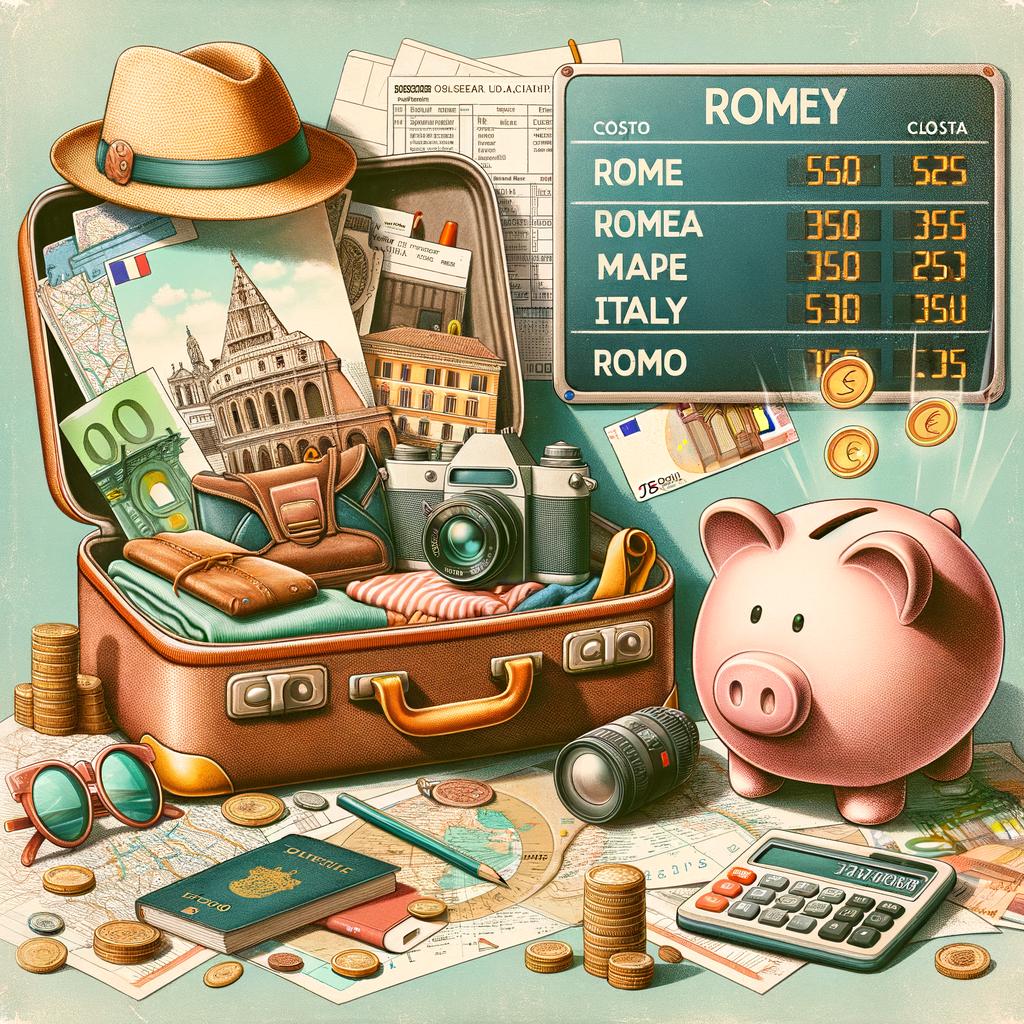Italy is a country that has captivated travelers for generations with its rich history, stunning landscapes, and world-renowned cuisine. From the ancient ruins of Rome to the romantic canals of Venice, Italy offers a diverse range of attractions that cater to all types of travelers.
But what does it cost to travel to Italy? In this article, we will break down the expenses involved in visiting this beloved European destination and provide tips on how to make the most of your budget while exploring all that Italy has to offer.
One of the key reasons why Italy remains a popular travel destination is its iconic landmarks and cultural significance. The country boasts an impressive array of UNESCO World Heritage Sites, including the Colosseum in Rome, the Leaning Tower of Pisa, and the historic city of Florence. Whether you’re a history buff, art enthusiast, or food lover, Italy has something for everyone to enjoy.
When planning a trip to Italy, one of the first considerations for many travelers is the cost of transportation. Flights to Italy can vary significantly depending on factors such as time of booking, departure city, and seasonality. Finding cheap airfare may require flexibility in travel dates and booking well in advance. Additionally, once in Italy, visitors can choose from various modes of transportation such as trains, buses, rental cars, or even walking depending on their budget and itinerary.
Flight Costs
Italy is renowned for its rich culture, stunning landscapes, and delectable cuisine, making it a popular travel destination for visitors from around the world. However, one of the most common questions that prospective travelers ask is: what does it cost to travel to Italy? Flight costs play a significant role in determining the overall expenses of a trip to Italy. By employing some savvy strategies, travelers can save money on airfare and allocate more funds to enjoy their Italian adventure.
When considering flight costs to Italy, it’s essential to plan ahead and book tickets in advance. Typically, booking flights several months before your intended travel dates can result in lower prices. Additionally, being flexible with your travel dates and opting for mid-week flights rather than weekend departures can also lead to significant savings. Utilizing flight comparison websites and signing up for alerts from airlines can help travelers snag deals and discounts on airfare.
| Departure City | Average Round-Trip Flight Cost |
|---|---|
| New York City | $800 |
| London | $250 |
| Tokyo | $1000 |
By using these estimates as a baseline and following cost-saving techniques when booking flights, travelers can make more informed decisions about their budget for traveling to Italy and ensure they get the best possible deal on airfare.
Accommodation
Italy is renowned for its diverse landscapes, rich history, and delectable cuisine, making it a popular travel destination for many around the world. However, one of the biggest questions travelers have when planning a trip to Italy is: “What does it cost to travel to Italy?”.
When looking at accommodation options in Italy, travelers have several choices ranging from hotels, hostels, to Airbnb. Each option comes with its own set of pros and cons, as well as varying price points. Here is a breakdown of the average costs for each type of accommodation in different cities across Italy:
- Rome: In Rome, the capital city of Italy, hotel prices can range from $50 to $300 per night depending on the location and amenities. Hostels are a more budget-friendly option with prices starting at around $20 per night. Airbnb listings in Rome are abundant and offer unique accommodations at various price points.
- Florence: Accommodation prices in Florence tend to be slightly lower than in Rome. Hotels can cost anywhere between $40 to $200 per night, while hostels are available for about $15 per night. Airbnb options provide a mix of affordability and charm in this picturesque city.
- Venice: As one of the most popular tourist destinations in Italy, Venice tends to have higher accommodation costs. Hotels can range from $80 to $400 per night, while hostels provide budget-friendly options starting at around $25 per night. Airbnb listings in Venice offer a chance to stay in unique accommodations such as canal-side apartments or cozy lofts.
Food and Drink
When traveling to Italy, one of the highlights for many tourists is undoubtedly the opportunity to indulge in authentic and delicious Italian cuisine. From mouthwatering pasta dishes to delectable pizzas, Italy offers a plethora of culinary delights that are sure to tantalize your taste buds. However, many travelers may wonder: what does it cost to travel to Italy and enjoy the best Italian food without breaking the bank?
To help budget-conscious travelers make the most of their dining experiences in Italy, here are some tips on how to sample the best Italian cuisine without exceeding your budget:
- Look for local trattorias and osterias: Instead of dining at upscale restaurants in popular tourist areas, opt for cozy trattorias and osterias frequented by locals. Not only will you enjoy authentic Italian dishes at more reasonable prices, but you’ll also get a taste of true Italian culture.
- Share meals with companions: Italian portions tend to be generous, so consider splitting entrees or sharing dishes with your fellow travelers. This way, you can sample a variety of dishes without overspending.
- Explore street food markets: For a budget-friendly dining option, head to bustling street food markets where you can savor freshly prepared paninis, arancini, gelato, and other scrumptious treats at affordable prices.
By following these tips and being mindful of your dining choices, you can savor the exquisite flavors of Italy’s culinary scene without worrying about exceeding your travel budget. After all, experiencing the rich gastronomic heritage of Italy is an integral part of any memorable trip to this enchanting country.
Transportation
Italy offers various transportation options for travelers to explore its beautiful cities and countryside. The cost of public transportation in Italy varies depending on the city, but generally, a single ticket for a bus or metro ride can range from €1.50 to €2.50. For those planning to visit multiple attractions in a day, it might be more cost-effective to purchase a day pass or travel card, which typically costs around €7-€10.
Renting a car in Italy is another popular choice for travelers who want the freedom to explore off-the-beaten-path destinations at their own pace. The cost of renting a car in Italy can start from €30-€50 per day for a basic compact car and can go up depending on the vehicle type and rental company. Additionally, travelers should consider factoring in fuel costs, tolls on highways, and parking fees when budgeting for a road trip through Italy.
One of the most scenic ways to travel around Italy is by train. The country has an extensive rail network that connects major cities like Rome, Florence, Venice, and Milan. Train tickets in Italy are relatively affordable compared to other European countries, with prices varying based on the distance traveled and the class of service.
For example, a one-way ticket from Rome to Florence can cost between €20-€50 for a second-class seat on a high-speed train. Travelers can also save money by booking train tickets in advance or opting for regional trains instead of faster intercity services.
| Transportation Option | Average Cost |
|---|---|
| Public Transportation (single ticket) | €1.50 – €2.50 |
| Rental Car (per day) | €30 – €50 |
| Train Ticket (intercity) | €20 – €50 |
Activities and Attractions
When planning a trip to Italy, it’s essential to consider the costs of various activities and attractions that you might want to experience while exploring this beautiful country. From guided tours of historical landmarks to visits to renowned museums and sightseeing excursions, there is no shortage of things to do in Italy. However, understanding the pricing for these activities can help you create a realistic budget for your trip.
Guided Tours
One of the best ways to immerse yourself in Italy’s rich history and culture is by joining guided tours. The cost of guided tours in Italy can vary depending on the duration, location, and included amenities.
For example, a half-day walking tour of a city like Rome or Florence may cost around $50-$100 per person, while a full-day tour that includes transportation to multiple attractions could range from $100-$200 per person. It’s advisable to research different tour companies and read reviews to ensure you’re getting value for money.
Museums and Galleries
Italy is home to some of the world’s most famous museums and art galleries, such as the Vatican Museums in Rome and the Uffizi Gallery in Florence. The cost of entrance fees for these cultural institutions can vary, with prices typically ranging from $10-$25 per person.
Many museums offer discounted admission for students, seniors, and children, so be sure to inquire about any available discounts before purchasing tickets. Additionally, consider investing in city passes that provide access to multiple attractions at a reduced rate.
Sightseeing Excursions
Whether you’re exploring ancient ruins like Pompeii, cruising along the Amalfi Coast, or taking a gondola ride in Venice, sightseeing excursions in Italy offer unforgettable experiences for travelers. The costs of these excursions can vary significantly based on the location and activities included.
For instance, a day trip to Pompeii might cost around $50-$100 per person, while a gondola ride in Venice could range from $80-$150 depending on the duration and route. Researching different tour operators and comparing prices can help you find affordable options for sightseeing during your Italian adventure.
By carefully considering the costs of activities and attractions while planning your trip to Italy, you can create an itinerary that aligns with your budget without missing out on must-see experiences. Whether you’re interested in guided tours of historic sites, exploring world-class museums, or indulging in authentic Italian cuisine during food tours, there are options available for every traveler at different price points throughout Italy.
Remember to factor these expenses into your overall travel budget to ensure a memorable and financially manageable journey through this captivating country.
Shopping
Italy is renowned for its vibrant fashion scene, exquisite craftsmanship, and charming local products that make for perfect souvenirs. When visiting Italy, it’s important to budget for shopping to bring home a piece of this beautiful country. From high-end designer boutiques to quaint artisan shops, there is something for every shopper in Italy.
Souvenirs
One of the most popular items to bring back from Italy are souvenirs that capture the essence of the country. Items like hand-painted ceramics from the Amalfi Coast, Murano glass from Venice, or olive oil and balsamic vinegar from Tuscany make for unique gifts and mementos. Prices can vary depending on the quality and craftsmanship, so it’s essential to plan ahead and set aside a budget specifically for souvenirs.
Fashion
Italy is a fashion capital of the world, with cities like Milan known for luxury brands and high-end designers. While shopping at designer boutiques can be expensive, there are also opportunities to find deals at outlet stores or during sales seasons. Additionally, markets like Porta Palazzo in Turin or Mercato di San Lorenzo in Florence offer a more affordable alternative for trendy clothing and accessories.
Local Goods
Exploring local markets in Italy is a great way to discover unique products and support small businesses. Whether you’re interested in leather goods from Florence, gourmet food products from Sicily, or handmade lace from Burano, each region has its specialties to explore. Setting aside a portion of your budget for these authentic Italian goods ensures you can take home a piece of Italy’s rich cultural heritage without overspending.
When planning your trip to Italy, don’t forget to consider expenses related to shopping as part of your overall budget planning. By setting aside specific amounts for souvenirs, fashion items, and local goods, you can enjoy a fulfilling shopping experience while staying within your travel budget constraints.
Overall Budget Planning
Italy is undoubtedly a popular travel destination for people from all around the world, offering a rich history, beautiful architecture, delectable cuisine, and stunning landscapes. However, one of the most pressing questions for many travelers is “what does it cost to travel to Italy?” Planning ahead and creating a budget can help ensure you make the most of your trip without overspending.
When considering the costs of traveling to Italy, it’s important to break down expenses into key categories such as flight costs, accommodation, food and drink, transportation, activities and attractions, shopping, and overall budget planning. Finding cheap airfare to Italy is possible by using flight comparison websites and booking in advance. Accommodation prices vary depending on the city you are visiting, with options ranging from hotels to hostels and Airbnb properties to suit different budgets.
Sampling delicious Italian cuisine can be done affordably by dining at local trattorias or markets instead of high-end restaurants. Public transportation in Italy is efficient and cost-effective, but renting a car or taking trains may be necessary for certain trips. When planning activities and sightseeing tours, be sure to look out for discounted tickets or free entry days at museums and landmarks.
Setting aside a budget for shopping is also essential if you want to bring back souvenirs or indulge in fashion purchases while in Italy. By carefully planning each aspect of your trip budget ahead of time, you can enjoy everything that Italy has to offer without worrying about overspending.
Frequently Asked Questions
Why Is Italy So Expensive to Travel To?
Italy is known for its rich history, beautiful architecture, and delicious cuisine, which all contribute to the high cost of traveling there. Accommodation, dining out, transportation, and tourist attractions can be expensive compared to other destinations. Additionally, popular cities like Rome, Venice, and Florence tend to attract a large number of tourists year-round, driving up prices.
Is Traveling to Italy Affordable?
Traveling to Italy can be affordable if planned carefully. Choosing budget accommodations, eating at local cafes and trattorias instead of touristy restaurants, utilizing public transportation, and purchasing tickets for attractions in advance can help keep costs down. Traveling during the shoulder seasons or offseason can also result in lower prices for accommodations and flights.
How Long Should a Trip to Italy Be?
The ideal length for a trip to Italy depends on personal preferences and interests. However, a minimum of one week is recommended to truly experience the highlights of this diverse country. For first-time visitors, spending around 10-14 days exploring multiple cities like Rome, Florence, Venice, and the Amalfi Coast can provide a good overview of what Italy has to offer.
For those looking to delve deeper into specific regions or immerse themselves in Italian culture, a longer trip may be necessary. Ultimately, the length of your stay should align with your travel goals and budget constraints.

I’m a passionate traveler, writer, and Italophile. My fascination with Italy’s history, art, and culture has led me on countless adventures across the Italian landscape. Through “I Live Italy,” I share my love for this extraordinary country and aims to inspire others to explore its boundless beauty.




